Konami has released many Special Summoning techniques from Ritual, Fusion, Synchro, Xyz, Pendulum and Links. Over the years, the mechanics have evolved, giving new interaction and play styles. Sometimes, the anime provides these evolutions semi-official terms. Other times, they are treated as a gimmick. This article will be one of the six-part series looking at the evolution for each summoning mechanic. Some of these evolutions haven't appeared in the real game yet. I will be using terms from the anime to describe the evolutions. This article will assume you know how each summoning mechanic works.
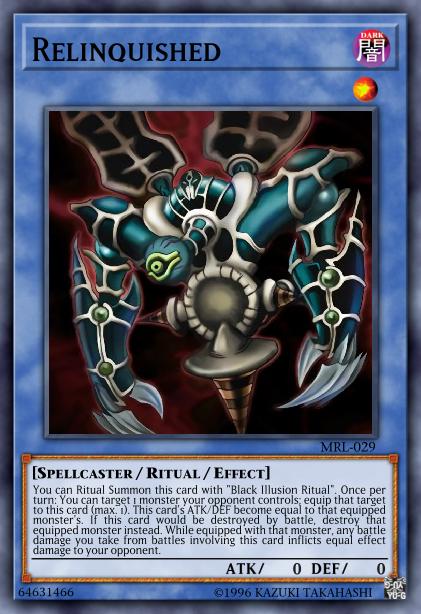
Ritual Summon
Being the OG Special Summoning mechanic along with fusion, have existed the longest. However, unlike fusions, they have been neglected until recently. Despite this, Rituals have evolved on their own since the beginning.
Flexible Ritual Spell
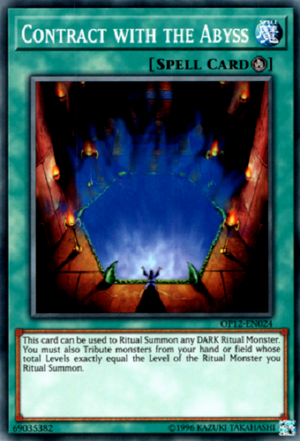 In 2003, Contract with the Abyss debuted. It was the first Ritual Spell Card to allow players to Ritual Summon a Ritual Monster other than a specific Ritual Monster. This was huge, since Ritual Spell Cards were specific in the monster it summons. It's because of this specificity that cards like Pre-Preparation of Rites was able to support the older weaker Rituals and ignore the more capable modern Rituals. Contract with the Abyss enables the player to Ritual Summon any DARK Attribute Ritual Monsters. Konami would eventually release the Ritual Spell Card, Earth Chant and Sprite's Blessing, for EARTH and LIGHT Attribute Ritual Monsters.
In 2003, Contract with the Abyss debuted. It was the first Ritual Spell Card to allow players to Ritual Summon a Ritual Monster other than a specific Ritual Monster. This was huge, since Ritual Spell Cards were specific in the monster it summons. It's because of this specificity that cards like Pre-Preparation of Rites was able to support the older weaker Rituals and ignore the more capable modern Rituals. Contract with the Abyss enables the player to Ritual Summon any DARK Attribute Ritual Monsters. Konami would eventually release the Ritual Spell Card, Earth Chant and Sprite's Blessing, for EARTH and LIGHT Attribute Ritual Monsters.
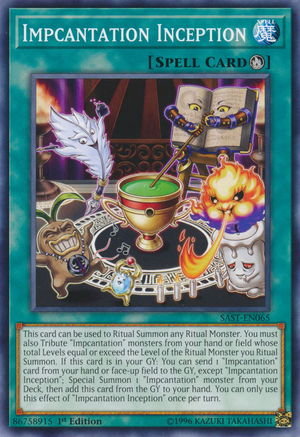 This flexibility spawned the first attempt of an archetype/series Ritual Monsters, Demise and Ruin. Their Ritual Spell Card, End of the World, was designed to Ritual Summon either ritual monster. Eventually, Konami updated this mechanic. Many Ritual Archetypes often have Ritual Spell Cards that enables the user to Ritual Summon any member of their Archetype (e.g. Machine Angel Ritual, Chaos Form, Gishki Aquamirror, etc).
This flexibility spawned the first attempt of an archetype/series Ritual Monsters, Demise and Ruin. Their Ritual Spell Card, End of the World, was designed to Ritual Summon either ritual monster. Eventually, Konami updated this mechanic. Many Ritual Archetypes often have Ritual Spell Cards that enables the user to Ritual Summon any member of their Archetype (e.g. Machine Angel Ritual, Chaos Form, Gishki Aquamirror, etc).
Since then, Konami has lessened the restriction and increased the flexibility of Ritual Spells. For example, Meteornis Draitron, Advanced Ritual Art and Impcantation Inception enable players to Ritual Summon any Ritual Monsters provided they Tribute the correct Ritual Fodder.
Sending Tribute Fodder from the Deck
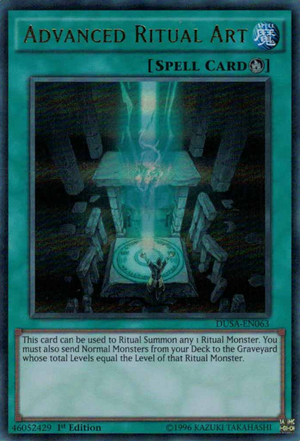 2006 saw the release of Advanced Ritual Art. This is a powerful Ritual Spell that allows the user to Ritual Summon using materials from the Deck. The drawback is that the materials have to be Normal Monsters. However, this drawback is non-existent if your Deck naturally uses Normal Monsters (e.g. Chaos Max Dragon and Blue-Eyes). The Black Luster Ritual archetype eventually made their version of Advanced Ritual Art. This is in the form of Super Soldier Synthesis with the restriction of the fodders having to be both Light and Dark Attribute. To this day, these two cards are the only cards to use Ritual materials from the Deck.
2006 saw the release of Advanced Ritual Art. This is a powerful Ritual Spell that allows the user to Ritual Summon using materials from the Deck. The drawback is that the materials have to be Normal Monsters. However, this drawback is non-existent if your Deck naturally uses Normal Monsters (e.g. Chaos Max Dragon and Blue-Eyes). The Black Luster Ritual archetype eventually made their version of Advanced Ritual Art. This is in the form of Super Soldier Synthesis with the restriction of the fodders having to be both Light and Dark Attribute. To this day, these two cards are the only cards to use Ritual materials from the Deck.
Single Monster Tribute
I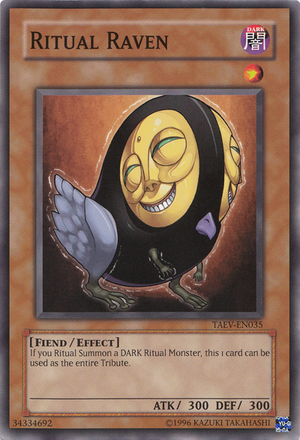 n 2007, Ritual Raven made its debut. Ritual Raven mitigates the massive minus of Rituals by acting as the full requirement for the Ritual Summoning of a Dark Monster. The Gishki archetype soon appropriated this gimmick in the form of 'Gishki Shadow' and 'Gishki Vision', but for Water Ritual Monsters. Eventually, Nekroz would also follow suit in the form of 'Shurit, Strategies of the Nekroz', but for Nekroz Ritual Monsters.
n 2007, Ritual Raven made its debut. Ritual Raven mitigates the massive minus of Rituals by acting as the full requirement for the Ritual Summoning of a Dark Monster. The Gishki archetype soon appropriated this gimmick in the form of 'Gishki Shadow' and 'Gishki Vision', but for Water Ritual Monsters. Eventually, Nekroz would also follow suit in the form of 'Shurit, Strategies of the Nekroz', but for Nekroz Ritual Monsters.
Konami has since retired this gimmick. However, this could be because many modern Ritual Archetypes don't have as many Ritual Monsters as Gishki or Nekroz.
Fodder Effect Inheriting
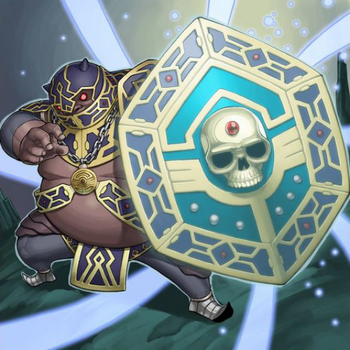 In 2009, Djinn the Rituals made its debut. Djinn boosts the power of Ritual Monsters by giving additional effects. It's almost like the Ritual Monster is inheriting the effects from the "Djinn" monsters themselves. This gimmick soon found itself in many Ritual decks, such as Black Luster Soldier (Evening Twilight Knight and Beginning Knight), Ruin/Demise and Vendreads.
In 2009, Djinn the Rituals made its debut. Djinn boosts the power of Ritual Monsters by giving additional effects. It's almost like the Ritual Monster is inheriting the effects from the "Djinn" monsters themselves. This gimmick soon found itself in many Ritual decks, such as Black Luster Soldier (Evening Twilight Knight and Beginning Knight), Ruin/Demise and Vendreads.
Konami has further experimented with this gimmick. Instead of the Ritual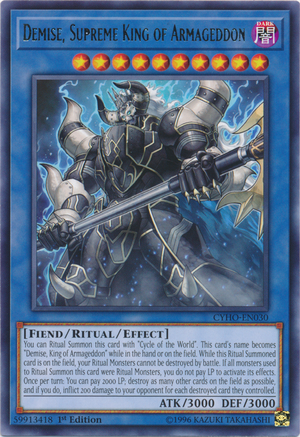 inheriting effects from the fodder, the Ritual Monster now unlocks additional power if Ritual Summoned using certain fodder. Examples of these Rituals are Draitron Meteornis=Dra, Draitron Meteornis=QUA, Salamangreat Emerald Eagle, Blue-Eyes Chaos Dragon, Ruin Supreme Queen of Oblivion and Demise, Supreme King of Armageddon.
inheriting effects from the fodder, the Ritual Monster now unlocks additional power if Ritual Summoned using certain fodder. Examples of these Rituals are Draitron Meteornis=Dra, Draitron Meteornis=QUA, Salamangreat Emerald Eagle, Blue-Eyes Chaos Dragon, Ruin Supreme Queen of Oblivion and Demise, Supreme King of Armageddon.
Ritual Spell with Additional Effects
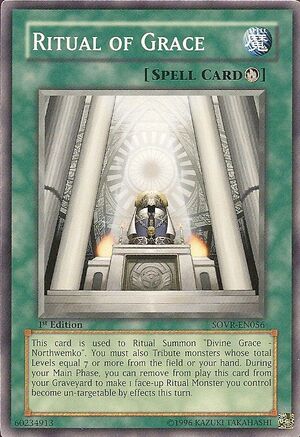 In 2009, Konami released the Ritual Spell Card, Ritual of Grace, to Ritual Summon the Ritual Monster, Divine Grace - Northwemko. It is the first Ritual Spell Card to have an additional effect other than to Ritual Summon. Ritual of Grace has the additional effect of protecting your Rituals from targeting effects. Since then, Ritual Spells evolved to almost always have an additional effect.
In 2009, Konami released the Ritual Spell Card, Ritual of Grace, to Ritual Summon the Ritual Monster, Divine Grace - Northwemko. It is the first Ritual Spell Card to have an additional effect other than to Ritual Summon. Ritual of Grace has the additional effect of protecting your Rituals from targeting effects. Since then, Ritual Spells evolved to almost always have an additional effect.
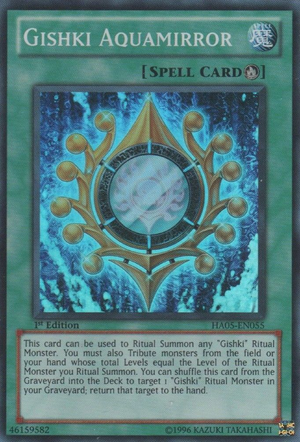 Currently, these are the different Ritual Spells with additional effects: Ritual of Destruction, Luminous Dragon Ritual, Hymn of Light, Oracle of the Herald, Nekroz Mirror, Gishki Aquamirror , Nekroz Kaleidoscope, Nekroz Cycle, Good & Evil in the Burning Abyss, Dark Dragon Ritual, Prediction Ritual, Super Soldier Ritual, Odd-Eyes Advent, Primal Cry, Revendread Origin, Cynet Mining, Cycle of the World, Revendread Evolution, Litmus Doom Ritual, Rise of the Salamangreat, Rebirth of Nephthys, Impcantation Inception, A.I. Ritual and Meteornis Draitron.
Currently, these are the different Ritual Spells with additional effects: Ritual of Destruction, Luminous Dragon Ritual, Hymn of Light, Oracle of the Herald, Nekroz Mirror, Gishki Aquamirror , Nekroz Kaleidoscope, Nekroz Cycle, Good & Evil in the Burning Abyss, Dark Dragon Ritual, Prediction Ritual, Super Soldier Ritual, Odd-Eyes Advent, Primal Cry, Revendread Origin, Cynet Mining, Cycle of the World, Revendread Evolution, Litmus Doom Ritual, Rise of the Salamangreat, Rebirth of Nephthys, Impcantation Inception, A.I. Ritual and Meteornis Draitron.
In fact, Gishki's Ritual Spell, Gishki Aquamirror, is the most infamous of these. This is because the Aquamirror's additional effects allow Gishki players to recycle the Ritual Spell and Ritual Monsters over and over again.
Using opponent's monsters
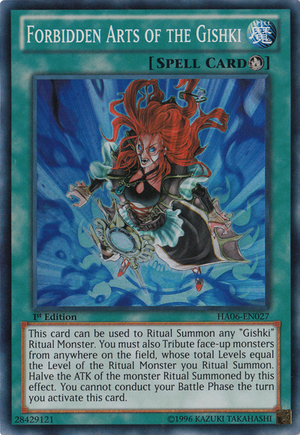 2010 saw the release of Forbidden Arts of the Gishki. A Ritual Spell Card that is similar to Super Polymerization. Players can Tribute monsters from both sides of the field. However, this comes with a price where the Ritual Monster it summons has to be a Gishki Monster, and its ATK is halved.
2010 saw the release of Forbidden Arts of the Gishki. A Ritual Spell Card that is similar to Super Polymerization. Players can Tribute monsters from both sides of the field. However, this comes with a price where the Ritual Monster it summons has to be a Gishki Monster, and its ATK is halved.
To this day, this is the ONLY card that allows players to tribute materials from both sides of the field.
Paying Lifepoints
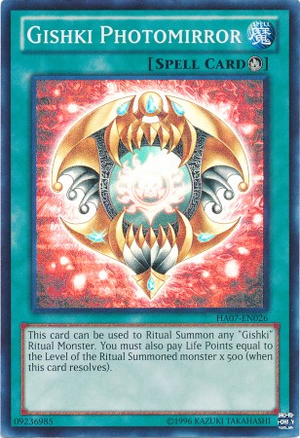 In 2011, Konami debuted the Ritual Spell Gishki Photomirror. Gishki Photomirror is a Ritual Spell that allows the player to Ritual Summon a "Gishki" Ritual Monster by paying LP. The player must pay 500LP for each Level of the Ritual Monster they're trying to summon. For example, if I wanted to Ritual Summon a Level 6 Ritual Monster, I'll need to pay 3000 LP. It is the first Ritual Spell and so far the only Ritual Spell that requires the player to pay LP.
In 2011, Konami debuted the Ritual Spell Gishki Photomirror. Gishki Photomirror is a Ritual Spell that allows the player to Ritual Summon a "Gishki" Ritual Monster by paying LP. The player must pay 500LP for each Level of the Ritual Monster they're trying to summon. For example, if I wanted to Ritual Summon a Level 6 Ritual Monster, I'll need to pay 3000 LP. It is the first Ritual Spell and so far the only Ritual Spell that requires the player to pay LP.
Hand Effects
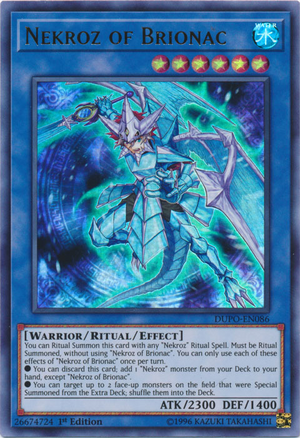 In 2014, Konami introduced the Nekroz archetype to the world. They are a powerful Ritual Archetype that set the trend for many modern Rituals. Most Ritual Monster in this archetype comes with hand effects. Players discard them to trigger effects ranging from searching, protection and gaining attack. The additional hand effect of Nekroz Ritual Monsters has undoubtedly inspired the design of Sauravis, The Ancient and Ascended, Impcantation Chalislime, Crealtar, The Impcantation Originator and the Megalith Ritual Monsters.
In 2014, Konami introduced the Nekroz archetype to the world. They are a powerful Ritual Archetype that set the trend for many modern Rituals. Most Ritual Monster in this archetype comes with hand effects. Players discard them to trigger effects ranging from searching, protection and gaining attack. The additional hand effect of Nekroz Ritual Monsters has undoubtedly inspired the design of Sauravis, The Ancient and Ascended, Impcantation Chalislime, Crealtar, The Impcantation Originator and the Megalith Ritual Monsters.
Using Extra Deck as Materials
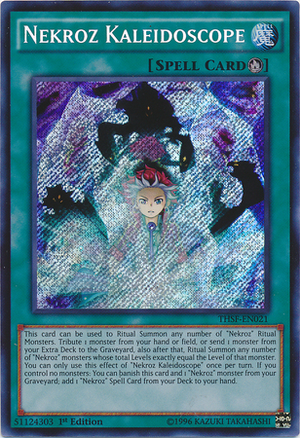 As mentioned previously, Nekroz set many trends for Rituals. In 2014, Konami released the Ritual Spell Card, Nekroz Kaleidoscope. It is a Ritual Spell Card that allows the player to use monsters from the Extra Deck as Tribute Materials to perform a Ritual Summon. However, you can only use one Extra Deck monster. This isn't a problem as most players used Nekroz Kaleidoscope to dump Herald of Arc Light to the Graveyard to Ritual Summon Unicore. Herald of Arc Light would then search for a Ritual Monster or Spell from the Deck.
As mentioned previously, Nekroz set many trends for Rituals. In 2014, Konami released the Ritual Spell Card, Nekroz Kaleidoscope. It is a Ritual Spell Card that allows the player to use monsters from the Extra Deck as Tribute Materials to perform a Ritual Summon. However, you can only use one Extra Deck monster. This isn't a problem as most players used Nekroz Kaleidoscope to dump Herald of Arc Light to the Graveyard to Ritual Summon Unicore. Herald of Arc Light would then search for a Ritual Monster or Spell from the Deck.
Konami would later use this gimmick again for the Ritual Spell Card, Odd-Eyes Advent. However, instead of restricting to only one Extra Deck Monster, players can send as many Extra Deck Monsters provided that the opponent has two or more monsters and the tribute fodders are Odd-Eyes monsters.
Ritual Summon from the GY
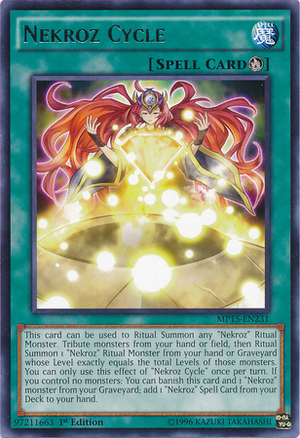 Nekroz also introduced the first card to Ritual Summon Rituals from the Graveyard in 2014 with Nekroz Cycle. Since then, Ritual Spell Cards often have the capability to Ritual Summon monsters from the Graveyard. Examples include Odd-Eyes Advent, Revendread Origin, Revendread Evolution and Meteornis Draitron.
Nekroz also introduced the first card to Ritual Summon Rituals from the Graveyard in 2014 with Nekroz Cycle. Since then, Ritual Spell Cards often have the capability to Ritual Summon monsters from the Graveyard. Examples include Odd-Eyes Advent, Revendread Origin, Revendread Evolution and Meteornis Draitron.
This is notable for Revendread Origin as it's easily one of the most practical Ritual Spell Cards seen in recent times with its ability to Ritual Summon monsters from the hand and Graveyard. It also can tribute monsters from the hand, field or banish materials from the Graveyard.
Using the Graveyard as Mateirals
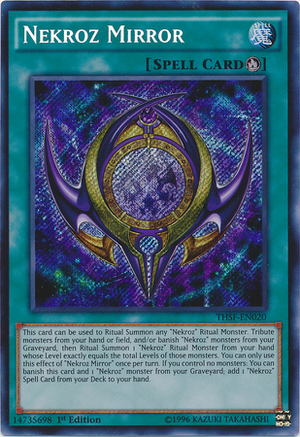 Nekroz also set the trend for Ritual Spell, having the ability to banish materials from the Graveyard to perform a Ritual Summon. Nekroz Mirror debuted in 2014. Its effects allow the user to banish "Nekroz" monsters from the Graveyard to perform a Ritual Summon.
Nekroz also set the trend for Ritual Spell, having the ability to banish materials from the Graveyard to perform a Ritual Summon. Nekroz Mirror debuted in 2014. Its effects allow the user to banish "Nekroz" monsters from the Graveyard to perform a Ritual Summon.
Since then, banishing monsters from the Graveyard has been quite common in modern Ritual Spell Cards (e.g. Red-Eyes Transmigration, Chaos Form, Revendread Origin, Rise of the Salamangreat and A.I. Ritual). Konami has also further evolved this mechanic with Machine Angel Absolute Ritual where instead of banishing the materials from the Graveyard, the materials are shuffled back to the Deck.
No Ritual Spell
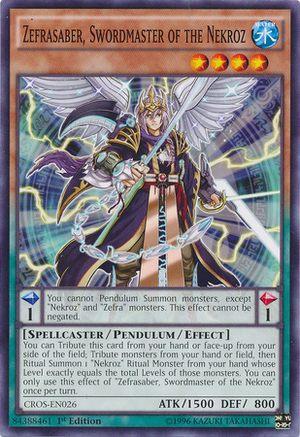 Konami released Zefrasaber, Swordmaster of the Nekroz in 2015. Zefrasaber is the first-ever monster (a Pendulum Monster) that can perform a Ritual Summon (Nekroz Ritual Monsters). It took Konami four years to revisit this gimmick, and from this gimmick, they created the Megalith archetype.
Konami released Zefrasaber, Swordmaster of the Nekroz in 2015. Zefrasaber is the first-ever monster (a Pendulum Monster) that can perform a Ritual Summon (Nekroz Ritual Monsters). It took Konami four years to revisit this gimmick, and from this gimmick, they created the Megalith archetype.
Ritual Trap Cards
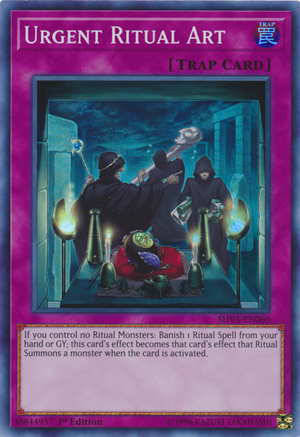 Konami created the first Trap Card that Ritual Summons a Ritual Monster known as Urgent Ritual Art in 2015. It's the counterpart of the Trap Card, Urgent Tuning, except this one is more convoluted. It requires having the Ritual Spell Card in the Graveyard first, which means this card could often lead to bricking.
Konami created the first Trap Card that Ritual Summons a Ritual Monster known as Urgent Ritual Art in 2015. It's the counterpart of the Trap Card, Urgent Tuning, except this one is more convoluted. It requires having the Ritual Spell Card in the Graveyard first, which means this card could often lead to bricking.
Soon after the release of Urgent Ritual Art, Konami began to release other Trap Cards that perform a Ritual Summon. Examples of Ritual Trap Cards include Vendread Reunion and Renewal of the World.
Konami's design of Ritual Trap Cards eventually inspires their creation of "Non-Ritual Spell" Spell Card in 2016.
'Non-Ritual Spell' Spell Card
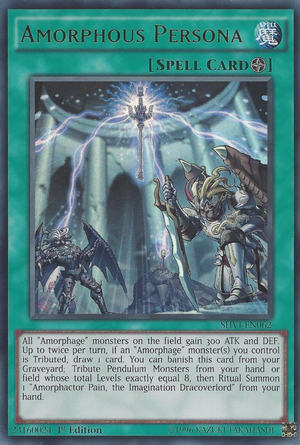 In 2016, Konami created the Amorphactor archetype with a Ritual Monster as its boss monster. However, instead of using a Ritual Spell or a monster effect to Ritual Summon the boss monster, the players must use the effect of the Field Spell: Amorphous Persona. This was the first time a player ever used a spell card that isn't a Ritual Spell to Ritual Summon a Ritual Monster.
In 2016, Konami created the Amorphactor archetype with a Ritual Monster as its boss monster. However, instead of using a Ritual Spell or a monster effect to Ritual Summon the boss monster, the players must use the effect of the Field Spell: Amorphous Persona. This was the first time a player ever used a spell card that isn't a Ritual Spell to Ritual Summon a Ritual Monster.
Konami would later experiment with this gimmick with different types of Spell Cards. Demise/Ruin has the Quick-Play Spell, Turning of the World. Dark Magician has the Quick-Play Spell, Secrets of the Dark Magic. The Quick-Play Spell, Megalith Unform, Ritual Summons the Megalith Rituals. Cyber Angel has Incarnated Machine Angel, a Continuous Spell Card. Fire Fist also has a Continuous Spell Card, Fire Formation - Domei.
Pre-Prep Compatibility
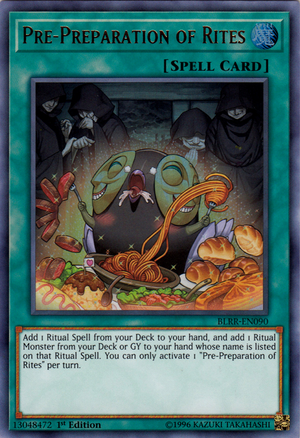 Pre-Preparation of Rites is a fantastic card that allows the user to fetch a Ritual Spell Card and Ritual Monster from the Deck. However, due to the wording of the card, Pre-Preparation of Rites only works if the Ritual Spell specifically list the name of the Ritual Monster. Therefore, the card doesn't work for most archetype Rituals as they don't list the specific name of the Ritual Monster. In 2016, Konami created the small series/archetype Shinobird, along with its Ritual Spell, Shinobird's Calling. Shinobird's Calling lists explicitly the name of both the Ritual Monsters it can Ritual Summon, so it's compatible with Pre-Preparation of the Rites.
Pre-Preparation of Rites is a fantastic card that allows the user to fetch a Ritual Spell Card and Ritual Monster from the Deck. However, due to the wording of the card, Pre-Preparation of Rites only works if the Ritual Spell specifically list the name of the Ritual Monster. Therefore, the card doesn't work for most archetype Rituals as they don't list the specific name of the Ritual Monster. In 2016, Konami created the small series/archetype Shinobird, along with its Ritual Spell, Shinobird's Calling. Shinobird's Calling lists explicitly the name of both the Ritual Monsters it can Ritual Summon, so it's compatible with Pre-Preparation of the Rites.
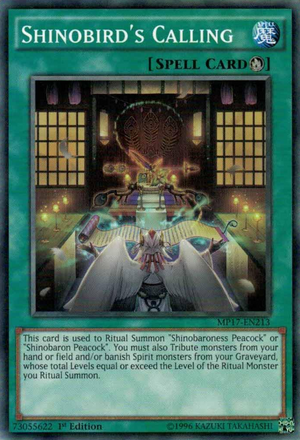 Writing down the specific name of each monster that can be Ritual Summoned can be difficult. Konami solved this by listing the specific name of the monster in the Ritual Spell's additional effects. Examples of these Ritual Spells include Revendread Origin, Cycle of the World, Rise of the Salamangreat and Rebirth of Nephthys. That way, players can fetch the Ritual Monster and Ritual Spell Card with Pre-Preparation of Rites.
Writing down the specific name of each monster that can be Ritual Summoned can be difficult. Konami solved this by listing the specific name of the monster in the Ritual Spell's additional effects. Examples of these Ritual Spells include Revendread Origin, Cycle of the World, Rise of the Salamangreat and Rebirth of Nephthys. That way, players can fetch the Ritual Monster and Ritual Spell Card with Pre-Preparation of Rites.
Ritual Summon from the Deck
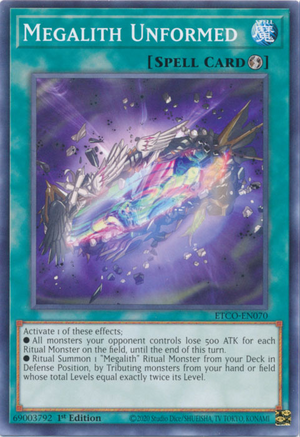 In 2020, Konami added Megalith Unformed to the lineup of the Megalith archetype. It is a Quick-Play Spell that grants the player the ability to Ritual Summon a Ritual Monster from the Deck provided you tribute monster that has double the level of the Ritual Monster. This is the first time Rituals are ever summoned directly from the Deck. Konami eventually further evolved this gimmick with the debut of Megalith Phul. It singlehandedly melds the archetype together and addressed the archetype's consistency, power and card economy issues. This is because Megalith Phul came with a powerful effect of also
In 2020, Konami added Megalith Unformed to the lineup of the Megalith archetype. It is a Quick-Play Spell that grants the player the ability to Ritual Summon a Ritual Monster from the Deck provided you tribute monster that has double the level of the Ritual Monster. This is the first time Rituals are ever summoned directly from the Deck. Konami eventually further evolved this gimmick with the debut of Megalith Phul. It singlehandedly melds the archetype together and addressed the archetype's consistency, power and card economy issues. This is because Megalith Phul came with a powerful effect of also  Ritual Summoning a "Megalith" Ritual Monster from the Deck without the double-level tribute requirement.
Ritual Summoning a "Megalith" Ritual Monster from the Deck without the double-level tribute requirement.
Konami then further evolved this as demonstrated with Connector of Nephthys. It has the same effect as Megalith Phul, except it doesn't require the player to tribute anything to perform a Ritual Summon.
Matching the ATK
 In 2020, Konami created the Draitron archetype which focuses on Ritual Summoning. However, instead of tributing monsters to match the levels, players tribute monsters to match the attack of the Ritual Monster. The Ritual Spell card that makes this happen is Meteornis Draitron. Great effects combined with the high attack of Draitron monsters, this has opened new doors for Rituals. This marks the first time Konami used something other than levels to perform a Ritual Summon.
In 2020, Konami created the Draitron archetype which focuses on Ritual Summoning. However, instead of tributing monsters to match the levels, players tribute monsters to match the attack of the Ritual Monster. The Ritual Spell card that makes this happen is Meteornis Draitron. Great effects combined with the high attack of Draitron monsters, this has opened new doors for Rituals. This marks the first time Konami used something other than levels to perform a Ritual Summon.
Seal of Serket & Cup of Sealed Soul (Anime Only)
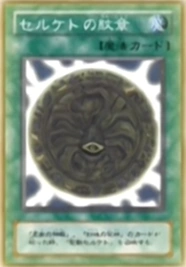 This type of Ritual debuted in 2001. In the anime, Mystical Beast Serket is a Ritual Monster, unlike its OCG/TCG counterpart. Odion played this Ritual Monster during the Battle City arc. To Ritual Summon Mystical Beast Serket, Odion used Normal Spell Card, Seal of Serket and Cup of Sealed Soul. However, instead of tributing monsters, the player must have Temple of the Kings, Seal of Serket and Cup of Sealed Soul face-up on the field. This is the first time a Ritual Summon doesn't require any Tributes, and it's the only time where it must have several face-up cards on the field to perform a Ritual Summon. This unique Ritual Summoning method only appears in the anime.
This type of Ritual debuted in 2001. In the anime, Mystical Beast Serket is a Ritual Monster, unlike its OCG/TCG counterpart. Odion played this Ritual Monster during the Battle City arc. To Ritual Summon Mystical Beast Serket, Odion used Normal Spell Card, Seal of Serket and Cup of Sealed Soul. However, instead of tributing monsters, the player must have Temple of the Kings, Seal of Serket and Cup of Sealed Soul face-up on the field. This is the first time a Ritual Summon doesn't require any Tributes, and it's the only time where it must have several face-up cards on the field to perform a Ritual Summon. This unique Ritual Summoning method only appears in the anime.
Note: Mystical Beast Serket may not have been a Ritual Monster in the anime, but it was colored blue incorrectly by the animators.
Attribute Requirement (Anime Only)
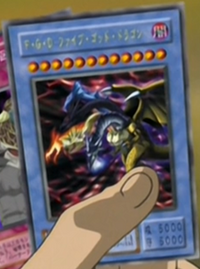 In 2002, the Ritual Variant of Five-Headed Dragon debuted in the anime. The Ritual Spell, Dragon Revival Ritual, is needed to summon this monster. However, instead of tributing monsters to match the levels, the Ritual Spell requires the user to Tribute one DARK, EARTH, FIRE, WATER and WIND attribute to Ritual Summon Five-Headed Dragon. It's convoluted but unique. To this day, we don't have a Ritual Spell that Tributes monsters to match the Attribute rather than Levels. This could be because this gimmick is too similar to Fusions.
In 2002, the Ritual Variant of Five-Headed Dragon debuted in the anime. The Ritual Spell, Dragon Revival Ritual, is needed to summon this monster. However, instead of tributing monsters to match the levels, the Ritual Spell requires the user to Tribute one DARK, EARTH, FIRE, WATER and WIND attribute to Ritual Summon Five-Headed Dragon. It's convoluted but unique. To this day, we don't have a Ritual Spell that Tributes monsters to match the Attribute rather than Levels. This could be because this gimmick is too similar to Fusions.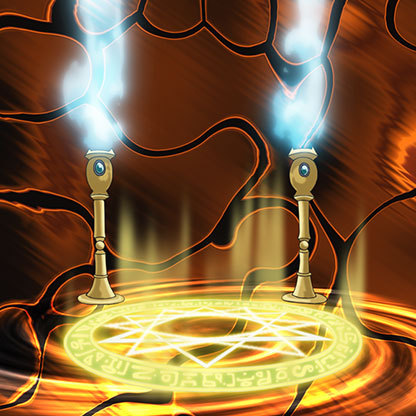
What's fascinating about this method is Five-Headed Dragon itself. It has previously appeared in the anime as a Fusion monster. Therefore, there's no reason why they made it into a Ritual Monster in this arc.




